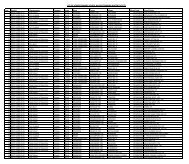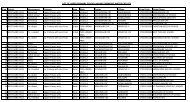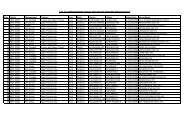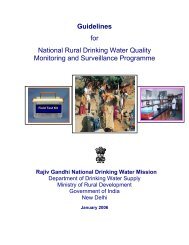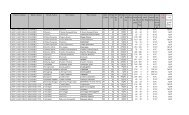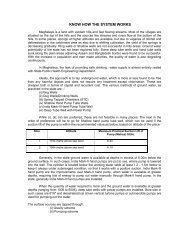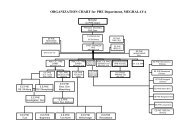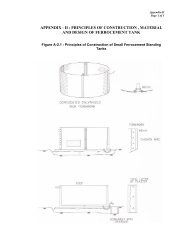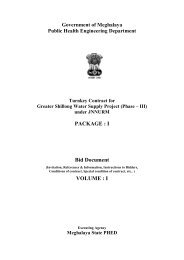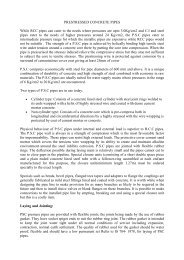PACKAGE : I Bid Document VOLUME : II - Public Health Engineering
PACKAGE : I Bid Document VOLUME : II - Public Health Engineering
PACKAGE : I Bid Document VOLUME : II - Public Health Engineering
You also want an ePaper? Increase the reach of your titles
YUMPU automatically turns print PDFs into web optimized ePapers that Google loves.
shall be lowered into the trench by removing at a time, one or two struts only, care<br />
being taken to see that no part of the shoring is disturbed or damaged. If necessary,<br />
additional struts may be fixed during lowering. After the pipe is lowered, it shall be<br />
laid in correct line and level by use of leveling instruments, sight rails theodolites etc.<br />
Care shall be taken to see that the longitudinal joints of the consecutive pipes are<br />
staggered by at least 30° and should be kept in upper third of the pipe line, if there are<br />
two longitudinal joints they should be on the sides. While assembling, the pipe faces<br />
shall be brought close enough to leave a uniform gap not exceeding 3mm. The spiders<br />
from inside and tightening rings from outside or other suitable equipment should be<br />
used to keep the two faces in shape and position till at least one runoff welding is<br />
carried out.<br />
The pipe faces shall first be tack-welded alternately at one or more diametrically<br />
opposite pairs of points. After completing tack-welding, full welding shall be carried<br />
out in suitable runs following a sequence of welding portions of segments<br />
diametrically opposite.<br />
Backfilling :<br />
Backfilling should closely follows the welding of joints of the pipe so that the<br />
protective coating does not subsequently damaged. Material harmful to the pipe line<br />
shall not be used for backfilling. Refilling shall be done in layers not exceeding<br />
300mm. Each layer shall be consolidated by watering and ramming, care being<br />
taken to prevent damage to the pipe line. The filling on the two sides of the pipe line<br />
should be carried out simultaneously.<br />
The spiders provided during assembly and welding shall be retained until the trench is<br />
refilled and consolidated. Where timbers are placed under the pipe line to aid<br />
alignment, these shall be removed before backfilling. For further precautions material<br />
to be used, backfilling reference should be in accordance with IS:3114-1985.<br />
Laying of pipes above ground:<br />
The procedure for handling the pipes as described earlier for lowering and assembling<br />
the pipes underground as described earlier should be followed for lifting and laying<br />
the pipes on supports or on ground. The pipe line may be allowed to rest on ground if<br />
the soil is non-aggressive. The ground should, however, be dressed to match the<br />
curvature of the pipe shell for an arch length substanding an angle of 120° at the<br />
center of pipes. Alternatively, the pipe line should be laid either on saddle or roller and<br />
rocker supports as specified by the Engineer-in-charge.<br />
DTS : Detailed Tender Specification. Page 173



